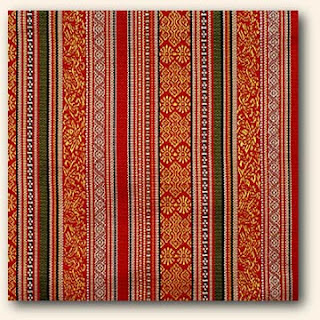Fabrics with stripes, plaid or checked patterns are called kanto.
There are different reasons why fabrics with certain patterns can be considered kanto
fabrics, and no clear rules exist for classifying them.
In the 16th centry, when kanto fabrics were introduced into Japan,
the striped and checked patterns felt new and fresh to chajin (Tea practitioners).
From that time on, they were used for making pouches for chaire (thick tea container), considerably
earlier than donsu and kinran. Even after donsu and kinran became highly valued,
the use of kanto fabrics did not decline because they provided a new range of fabric colors.
Here are a few examples:
 |
| Aoki kanto |
The name of this fabric comes from its original owner, Aoki, who was Toyotomi Hideyoshi shogun's retainer.
 |
| Kapitan kanto |
 |
| Kapitan kanto with large stripes |
 |
| Mumei kanto |
 |
| Sushuji kanto |
 |
| Tosai Kanto (10 colors) |
 |
| Nikuzushi kanto |
 |
| Nikuzushi kanto close up |
|
 |
| All three above: Sagara kanto |
 |
| Yoshino kanto |
It is said that Lady Yoshino favoured this pattern for her Uchikake, a coat dress. She was a wife of Haiya Jyoeki, a rich merchant who lived in Kyoto in 17th century.
 |
| Yoshino kanto |
My sensei had a beloved bunrin chaire with a shifuku made of this kereji in these exact colors. We used it for many years until she passed away. We don't know what happened to the chaire, but it remains one of my favorite fabrics.
*Fabric photos courtesy of
Kitamura Tokusai Fukusaten Co., Ltd., Kyoto, Japan.via the now closed website Tea Hyakka..













No comments:
Post a Comment